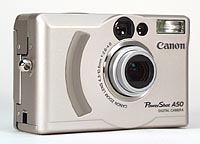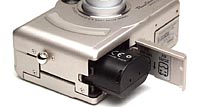
|


|
* |
1280x960 resolution |
|
* |
Compact, rugged case |
|
* |
2.5x Optical Zoom Lens |
|
* |
Great low-light ability (up to ISO400) |
|
* |
Panorama support, including 2x2 matrix! |
|
|

Canon PowerShot A50 Review Index:
Power
The power supply of the PowerShot A50 is a bit different than
most digicams. It ships with a 2CR5 lithium battery (non-rechargeable),
which they claim should be good for about 70 shots with the LCD
display on, 500 shots with it off, or 100 minutes of image playback.
Given the high cost of the 2CR5 batteries, we wouldn't recommend
them as a normal power source, but they make an excellent backup,
given their exceptional shelf-life.
 Alternatively, Canon sells a NiMH
battery pack/recharger/power adapter kit separately for the camera,
as their model number NP-100. The battery in this kit has a capacity
of only 650 mAh, a rather low rating when compared with a set
of 4 AA NiMH cells (which typically provide about 1300 mAh).
We were surprised then, by how well the Canon battery pack seemed
to last in actual use. (Canon claims it has a capacity of 70
shots with the LCD on, 280 with it off, and 70 minutes of image
playback.) We suspect that the discrepancy between its capacity
in mAh and it's apparent longevity in the camera may have to
do with the total energy it provides: AA NiMH batteries produce
a voltage of 1.2v each, or 4.8v for a set of four. The Canon
battery pack though, puts out 6 volts, a 25% increase in voltage.
Since power is the product of voltage and current, the 650 mAh
of the Canon battery should be more equivalent to AA cells with
a capacity of 813 mAh: While still not up to a set of AAs, it
isn't as far behind as you'd initially think. The A50 also appears
to be a fairly low-power camera, relative to other units we've
tested (see below.) Alternatively, Canon sells a NiMH
battery pack/recharger/power adapter kit separately for the camera,
as their model number NP-100. The battery in this kit has a capacity
of only 650 mAh, a rather low rating when compared with a set
of 4 AA NiMH cells (which typically provide about 1300 mAh).
We were surprised then, by how well the Canon battery pack seemed
to last in actual use. (Canon claims it has a capacity of 70
shots with the LCD on, 280 with it off, and 70 minutes of image
playback.) We suspect that the discrepancy between its capacity
in mAh and it's apparent longevity in the camera may have to
do with the total energy it provides: AA NiMH batteries produce
a voltage of 1.2v each, or 4.8v for a set of four. The Canon
battery pack though, puts out 6 volts, a 25% increase in voltage.
Since power is the product of voltage and current, the 650 mAh
of the Canon battery should be more equivalent to AA cells with
a capacity of 813 mAh: While still not up to a set of AAs, it
isn't as far behind as you'd initially think. The A50 also appears
to be a fairly low-power camera, relative to other units we've
tested (see below.)
An interesting component of the optional battery pack/charger
setup is the power adapter ("DC Coupler") it includes.
This gadget looks like a battery pack with a tail - it fits inside
the battery compartment, with the "tail" feeding out
through a small sliding hatch on the side of the camera. We saw
a similar system in the earlier A5 model, and generally like
it: There's no way the power cord could accidentally pop out
of the camera jack. On the other hand, you'll want to be careful
not to trip over the power cord, as it'll yank the tripod over
before it pulls loose from the camera!
We've just recently begun measuring actual power consumption
of digicams, to try to introduce some objectivity to the topic.
Now, rather than vague impressions of how long a camera can run
on a set of batteries, we'll be able to see just how much power
the cameras use in each operating mode. Overall, the A50 had
lower power consumption in non-LCD and image-playback modes than
other cameras we've checked recently. Other operating modes appear
fairly typical. (We've tested several of the recent 2-megapixel
digicams, but haven't reported on them as yet, wanting to develop
a consistent approach first. From this point on though, we should
be featuring power consumption figures pretty regularly.) Here's
a table showing power consumption in various modes ("mA"
means "milliamps", or 1/1000 of an ampere of current):
|
Operating Mode |
Power Drain |
|
Capture Mode, w/LCD |
720 mA |
|
Capture Mode, w/o LCD |
110 mA |
|
Half-pressed shutter, no LCD |
350 mA |
|
Memory Write (Transient) |
1000 mA |
|
Flash Recharge (Transient) |
1200 mA |
|
Image Playback |
380 mA |
|
"Sleep" Mode (Auto power-down) |
10 mA (!) |
In looking at these figures, it seems that Canon's claim of
70 minutes of continuous playback is fairly conservative, given
the battery's rating of 650 mAh (that's milliamp-hours, or 650
milliamps for an hour). The raw capacity of the battery would
suggest that it should be able to power the camera in playback
mode for a full 100 minutes or so (650mAh divided by 380 mA,
times 60 minutes/hour). This shortfall is typical of digicams,
due to their very high current drains: Most battery life-tests
are performed at the so-called "0.1C" rate, with a
drain of 1/10th of their capacity. In the case of the Canon battery,
this would correspond to a test load of 65 mA, less than 20%
of the load the camera itself draws in playback mode. Overall,
Canon's battery-lifetime claims seem pretty reasonable, given
the measurements we made.
IMPORTANT NOTE: We're embarassed to report that the same
power-interlock switch that momentarily stymied us with the PowerShot
A5 did the same to us on the A50! The battery-compartment cover
has a "lock" slider next to it (see photo at right)
that keeps it from accidentally opening. It turns out this lock
is also a power switch: The camera won't turn on unless it's
in the "locked" position! Don't be fooled (as we were
for at least a few moments) into thinking that the camera is
dead after you've first installed the battery: Check the lock
to make sure it's not preventing battery power from reaching
the camera!
|

|